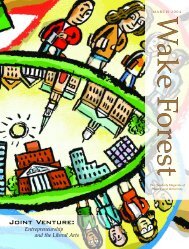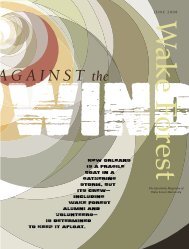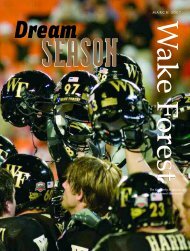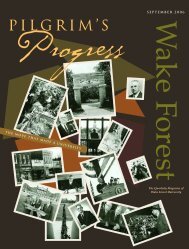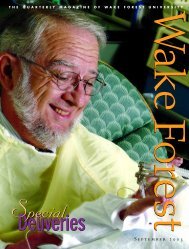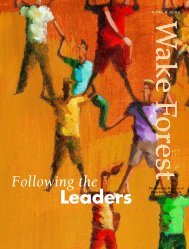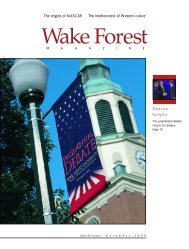Wake Forest Magazine June 2003 - Past Issues - Wake Forest ...
Wake Forest Magazine June 2003 - Past Issues - Wake Forest ...
Wake Forest Magazine June 2003 - Past Issues - Wake Forest ...
You also want an ePaper? Increase the reach of your titles
YUMPU automatically turns print PDFs into web optimized ePapers that Google loves.
C a m p u s C h r o n i c l e<br />
Eric Watts:<br />
shaping reality<br />
In the Harlem section of New<br />
York City in the 1920s, there<br />
concentrated a critical mass<br />
of cultural energy so potent<br />
that it sent shock waves<br />
through white society as well<br />
as black. Known as the Harlem<br />
Renaissance, its literature in<br />
its early stages was especially<br />
incisive and influential. In portraying<br />
the worth and dignity<br />
of African-Americans, writers<br />
such as Langston Hughes and<br />
Zora Neale Hurston gave content<br />
to concepts of civil rights<br />
and social equality and context<br />
to debates on race and democracy<br />
that energized the activism<br />
of W.E.B. Dubois and beyond.<br />
That the Harlem Renaissance<br />
ultimately veered toward the<br />
salacious did not diminish its<br />
power as a cultural catalyst;<br />
indeed, it magnified it. It is that<br />
power for social change that<br />
captivates Eric Watts and is a<br />
primary focus of his award-winning<br />
career as a young scholar.<br />
Watts, a recently tenured<br />
associate professor of communication<br />
at <strong>Wake</strong> <strong>Forest</strong>, specializes<br />
in rhetorical theory, the study<br />
of how public discourse affects<br />
social and cultural consciousness.<br />
He describes it as “the<br />
production of meaning”–how<br />
social reality is shaped. Among<br />
other influences he studies in<br />
this light is hip-hop, the phenomenal<br />
contemporary youth<br />
movement that has both transformed<br />
and been co-opted by<br />
mainstream commerce and<br />
culture.<br />
His work to date has earned<br />
him the respect of colleagues at<br />
the University and elsewhere,<br />
as evidenced by his selection<br />
for the 2002 New Investigator<br />
Award by the rhetoric and communication<br />
theory division of<br />
the National Communication<br />
Association. The award is given<br />
annually to a junior researcher<br />
in recognition of potential<br />
excellence in rhetorical and<br />
communication theory.<br />
According to Watts,<br />
rhetorical theory looks at the<br />
discursive strategies speakers<br />
and writers use to shape social<br />
reality and attain their persuasive<br />
objectives with the audience<br />
at hand. In the wake of<br />
September 11, for example,<br />
President Bush employed primarily<br />
emotional language in<br />
his public comments, in consonance<br />
with the country’s<br />
mood. By contrast, at the<br />
United Nations, American<br />
diplomatic language tends to<br />
be more intellectual and factbased,<br />
he notes.<br />
Its literary achievements<br />
were only part of the power of<br />
the Harlem Renaissance to penetrate<br />
and transform the mainstream<br />
culture of its era. Music<br />
was another, and when exposed<br />
to the unrestrained and ostentatiously<br />
sexual rhythms of jazz<br />
and blues, whites began migrating<br />
uptown from Greenwich<br />
Village hangouts to all-night<br />
cabarets and speakeasies in<br />
Harlem.<br />
Ultimately, the civil rights<br />
criticism of Hughes and Hurston,<br />
published in such serious journals<br />
as The Messenger, The Nation and<br />
black periodicals like The Crisis<br />
and The Opportunity, turned<br />
toward analysis of what Watts<br />
describes as an early strand of<br />
“blaxploitation”–Harlem After<br />
Hours, or Primitive Harlem,<br />
with its trade in Prohibitionera<br />
alcohol, drugs, and sex and<br />
the portrayal of vice in the<br />
films of Josephine Baker.<br />
Literature with gay and bisexual<br />
themes also emerged.<br />
But while this shift wasn’t<br />
anticipated or welcomed by<br />
many of the more serious<br />
Harlem Renaissance members,<br />
Watts notes that it too is a<br />
telling illustration of the<br />
power of popular culture to<br />
shape social reality. Another<br />
is the literature of African-<br />
American writers of the late<br />
1940s and 1950s like Richard<br />
Wright, Ralph Ellison, and<br />
James Baldwin–early voices<br />
of rage and indignation that<br />
culminated in the civil rights<br />
movement of the 1960s.<br />
Watts, a native of Cincinnati<br />
who earned his doctorate at<br />
Northwestern in 1995 and<br />
came to <strong>Wake</strong> <strong>Forest</strong> a year<br />
later, has been writing about<br />
hip-hop since the late 1980s. In<br />
its early years a strictly African-<br />
American genre with overtones<br />
of Black Nationalism, it moved<br />
over time into mainstream<br />
white youth culture. The most<br />
popular male musical artist in<br />
the world today, Eminem, is a<br />
white hip-hop singer.<br />
The shift seems to suggest<br />
that hip-hop’s core appeal all<br />
along might have been socioeconomic,<br />
which crosses the lines<br />
of skin color, instead of racial. In<br />
place of rage and aggression are<br />
its “Stop the Violence”<br />
appeals–an indication, in Watts’<br />
opinion, of the symbiotic relationship<br />
of transformation and<br />
cooptation between a radical<br />
new movement and the larger<br />
culture it is within. Another<br />
example he cites is the<br />
Budweiser “Whaaaas’ Up?”<br />
advertising campaign–black<br />
speech and behavior adopted by<br />
whites. Elvis Presley, Pop Art–<br />
examples are numerous of the<br />
new and the shocking becoming<br />
the standard and the familiar by<br />
its mutual interchange with<br />
prevailing cultural norms.<br />
In his research, Watts traces<br />
the lineage of discourse over<br />
time to show that fads rarely, if<br />
ever, are totally original. Some<br />
of the Harlem Renaissance<br />
writers, for example, drew upon<br />
the economic conservatism of<br />
Booker T. Washington, who<br />
two decades earlier had urged<br />
blacks to spend money in their<br />
own communities. Other writers<br />
were influenced by black<br />
folk culture, and still others by<br />
Emersonian transcendentalism.<br />
“A trend may be new in form,”<br />
Watts says, “but it is an evolutionary<br />
process. Over time the<br />
substance is consistent.”<br />
—David Fyten<br />
8 W ake <strong>Forest</strong> <strong>Magazine</strong>



